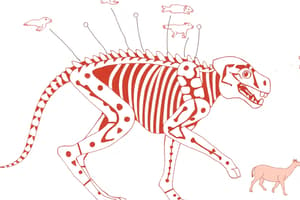Podcast
Questions and Answers
What is the concept of the classification of motor skills?
What is the concept of the classification of motor skills?
Classifying skills into general categories helps us to understand the demands those skills place on the performer/learner.
What are the learning objectives of the classification of motor skills? (Select all that apply)
What are the learning objectives of the classification of motor skills? (Select all that apply)
- Describe the two dimensions used to classify skills in the Gentile taxonomy (correct)
- Identify key historical figures in motor skill development
- Discuss ways to use the Gentile taxonomy in physical rehabilitation (correct)
- Define and distinguish the terms actions, movements, and neuromotor processes (correct)
What are skills?
What are skills?
Tasks or activities that have specific goals to achieve.
What do motor skills require?
What do motor skills require?
What are movements?
What are movements?
What do actions, movements, and neuromotor processes represent?
What do actions, movements, and neuromotor processes represent?
What does motor learning involve the study of?
What does motor learning involve the study of?
What does motor control involve the study of?
What does motor control involve the study of?
Motor development involves the study of __________.
Motor development involves the study of __________.
What is an example of a feedback loop of someone kicking a soccer ball?
What is an example of a feedback loop of someone kicking a soccer ball?
Flashcards are hidden until you start studying
Study Notes
Classification of Motor Skills
- Classification aids in understanding the demands placed on learners in performing motor skills.
- Skills can be categorized to simplify analysis and teaching methods.
Learning Objectives
- Define actions, movements, and neuromotor processes, providing clear examples.
- Understand common characteristics in motor skill classifications and differentiate between skill categories with specific examples.
- Learn two dimensions in the Gentile taxonomy of motor skills: task and environmental context, associated with performance characteristics.
- Apply the Gentile taxonomy in contexts such as physical rehabilitation and sports education.
Skills and Actions
- Skills are tasks with clear action goals that require voluntary control of body movements.
- Examples include walking and playing an instrument.
- "Actions" is often synonymous with motor skills.
Characteristics of Skills and Actions
- Skills aim to achieve specific goals and can be performed voluntarily.
- Essential elements include controlling movement of joints and body segments.
- Skills must be learned and refined through practice.
- Skill proficiency is marked by consistency, performance across varying conditions, and efficiency.
Movements and Neuromotor Processes
- Movements are defined as specific motion patterns of joints and body segments.
- Neuromotor processes refer to the underlying mechanisms of the nervous and muscular systems controlling actions and movements.
Interrelation of Actions, Movements, and Neuromotor Processes
- A sequence prioritizing motor control: achieving action goals, discovering effective movement patterns, and refining neuromotor processes for efficiency.
- Individuals may use different movement patterns to achieve the same action goal, illustrating many-to-one and one-to-many relationships.
- Example: Various ways to drink coffee demonstrate many-to-one relationships; one movement pattern may serve different actions.
- Diverse measures are needed to evaluate actions, movements, and neuromotor processes effectively.
Study of Motor Skills: Learning, Control, and Development
- Motor learning examines skill acquisition, performance enhancement, and skill reacquisition post-injury.
- Motor control focuses on the neuromuscular system's function in activating and coordinating muscles for motor skills during both learning and performance phases.
- Motor development studies the progression of motor behavior across the human lifespan, from infancy to old age.
Studying That Suits You
Use AI to generate personalized quizzes and flashcards to suit your learning preferences.




